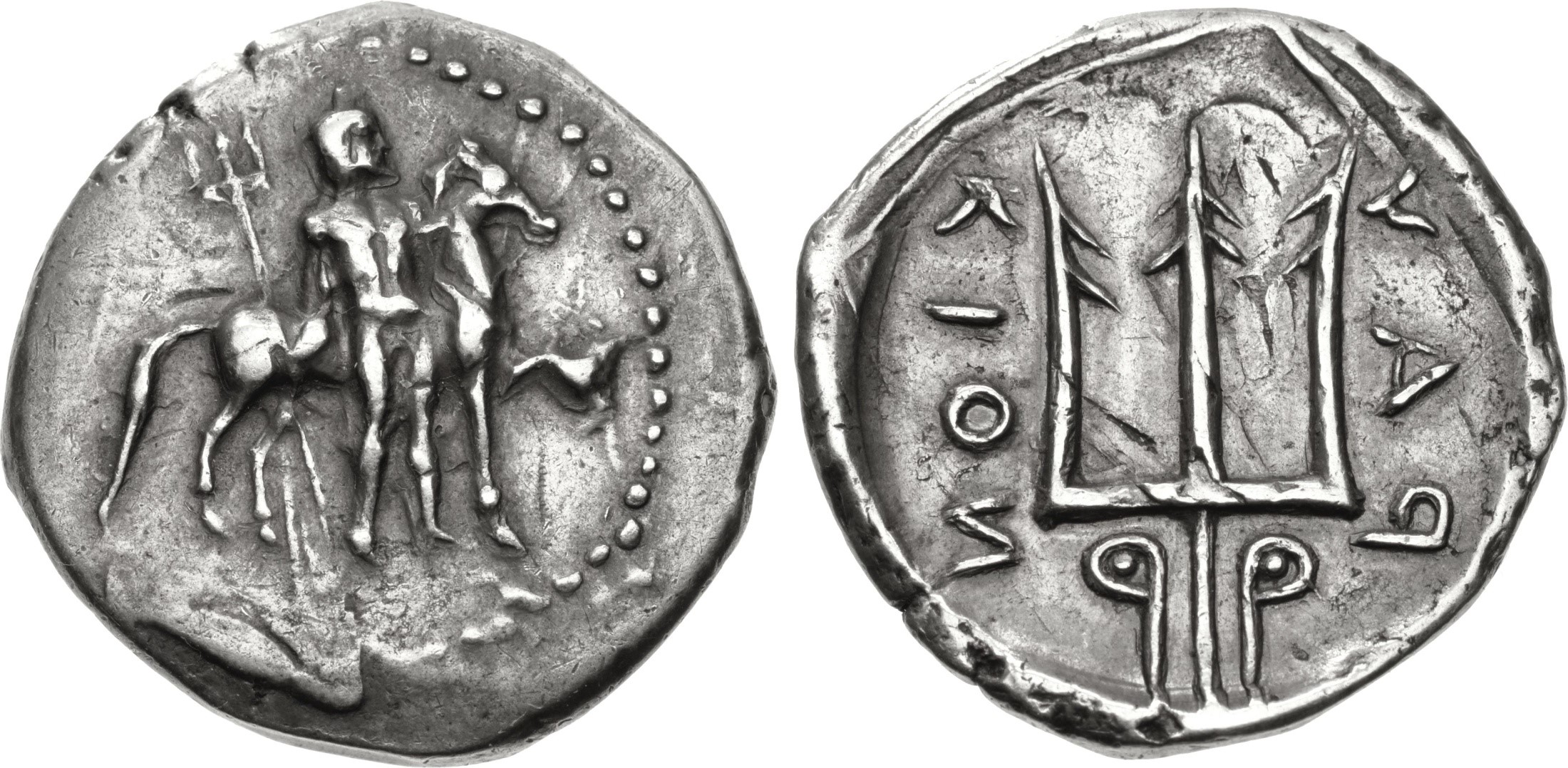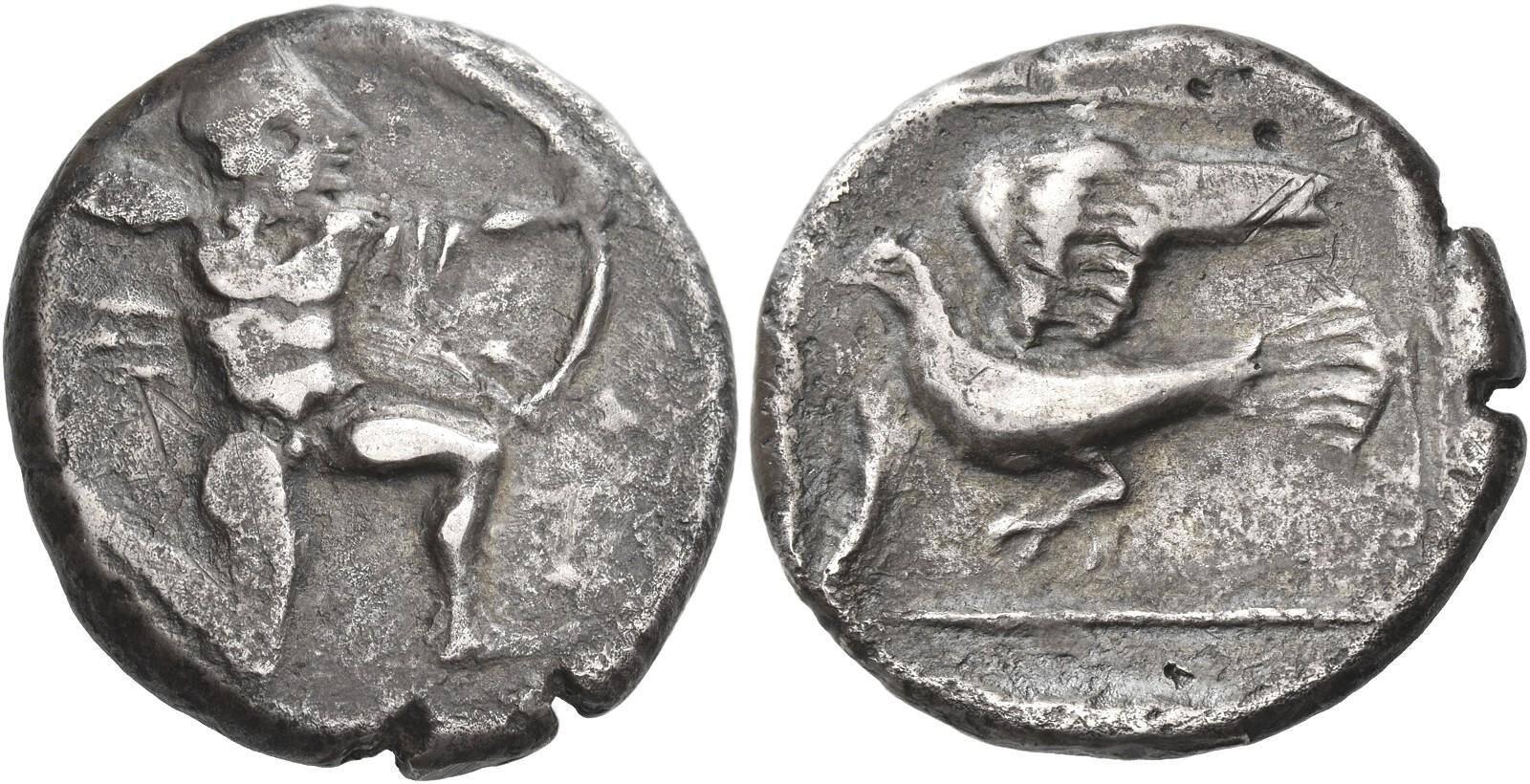330 BCE - 270 BCE | ΡΑΥΚΙΟΝ
Overstriking coin
Rhaucus_Künker, _168, _12_March_2010, _7315.jpg
[1]
Overstruck variety
Praesus_(under_Rhaucus).jpg
[2]
|
|
Sale(s)Sale(s) ᵖ:
|
Egger, 7 Jan. 1908, 525 = Leu/Münzen und Medaillen, 3 Dec. 1965, 338 = Künker, 168, 12 March 2010, 7315 = Classical Numismatic Group, May 2013, 331
|
| Private collection(s)Private collection(s) ᵖ:
|
W. Niggeler Collection ; R. Jameson Collection
|
|
Description
| ObverseInscription or printing placed on the obverse.:
|
Poseidon facing, naked, head right, holding trident in right hand, holding rein of horse standing right in left hand, in right field, rose(?).
|
ReverseInscription or printing placed on the reverse.:
|
ΡΑΥΚΙΟΝ (Greek) Trident head.
|
Mint and issuing power
| MintIdentifies the place of manufacture or issue of a numismatic object.:
|
Rhaucus
|
Ancient regionAncient region.
|
Crete
|
Modern countryModern country: Greece
|
AuthorityIdentifies the issuing power. The authority can be "pretended" when the name or the portrait of X is on the coin but he/she was not the issuing power. It can also be "uncertain" when there is no mention of X on the coin but he/she was the issuing power according to the historical sources:
|
|
Chronology
| FromIdentifies the initial date in a range assigned in a numismatic context. 330 BCE toIdentifies the final date in a range assigned in a numismatic context.. 270 BCE
|
Hellenistic 323-30 BC  periodTime period of the numismatic object. periodTime period of the numismatic object.
|
Physical description
MetalThe physical material (usually metal) from which an object is made.: Silver 
|
WeightWeight of the numismatic object (in grams). in grams: 10.8110.81 g <br />10,810 mg <br />
|
DenominationTerm indicating the value of a numismatic object. Examples: tetradrachm, chalkous, denarius.: stater 
|
AxisDescribes the directional relationship between the obverse and reverse of a numismatic object.: 66 mm <br />0.6 cm <br />
|
| DiameterDescribes diameter of an object (in mm).: 2828 mm <br />2.8 cm <br />
|
StandardStandard.: Aeginetic
|
References
| Coin referenceReference of the Coin:
|
R. Jameson, Collection R. Jameson (4 tomes), Paris, 1913-1932, no. 1343.
|
Coin series referenceReference to coin series study:
|
Svoronos 18901Svoronos 1890, n° 6, pl. XXIX, 11, Le Rider 19662Le Rider 1966, p. 106, 5, pl. XXVI, 18
|
| Coin series web referenceCoin series web references:
|
|
Description
| ObverseInscription or printing placed on the obverse.:
|
Heracles kneeling r., holding bow and arrow
|
ReverseInscription or printing placed on the reverse.:
|
Dove flying l. within linear frame
|
Mint and issuing power
| MintIdentifies the place of manufacture or issue of a numismatic object. ᵖ:
|
Praesus
|
Ancient regionAncient region. ᵖ
|
Crete
|
Modern countryModern country: Greece
|
AuthorityIdentifies the authority in whose name (explicitly or implicitly) a numismatic object was issued. ᵖ:
|
|
Chronology
| FromIdentifies the initial date in a range assigned in a numismatic context. 330 BCE toIdentifies the final date in a range assigned in a numismatic context.. 300 BCE
|
Hellenistic 323-30 BC  periodTime period of the numismatic object. periodTime period of the numismatic object.
|
Physical description
| DenominationTerm indicating the value of a numismatic object. Examples: tetradrachm, chalkous, denarius. ᵖ:
|
stater 
|
StandardStandard. ᵖ:
|
Aeginetic
|
References
References
- ^ Svoronos, Ioannes N. (1890), Numismatique de Crète ancienne, accompagnée de l'histoire, la géographie et la mythologie de l'île. Première partie, description des monnaies, 2 vol., Macon, Impr. Protat frères.
- ^ Le Rider, Georges (1966), Monnaies crétoises du Ve au Ier siècle av. J.-C., Paris, Geuthner, 345 p. and 42 pl.

